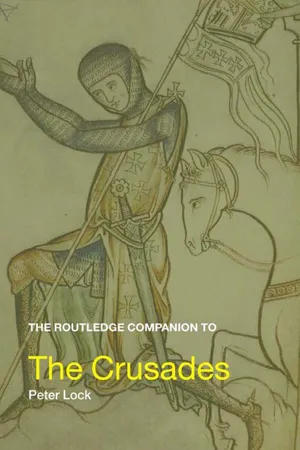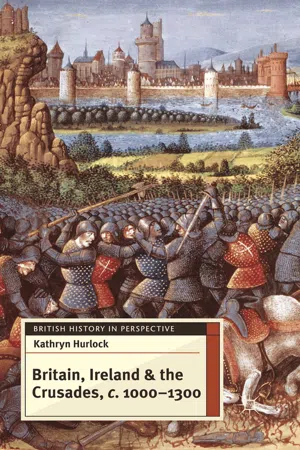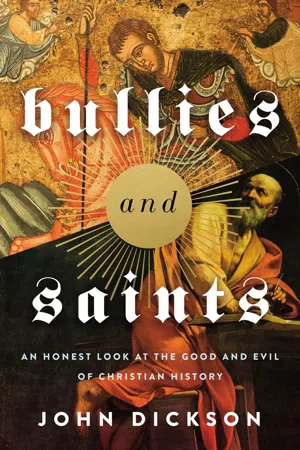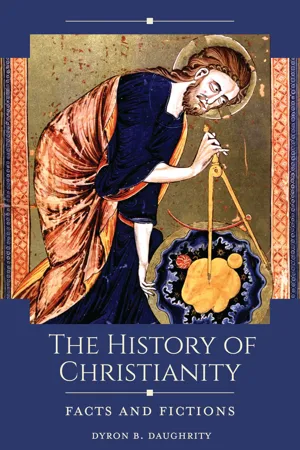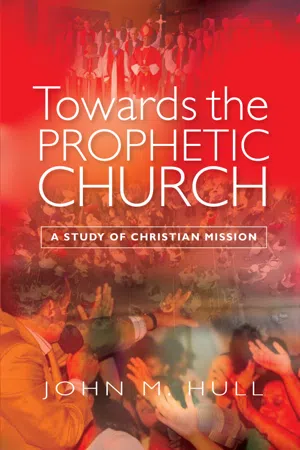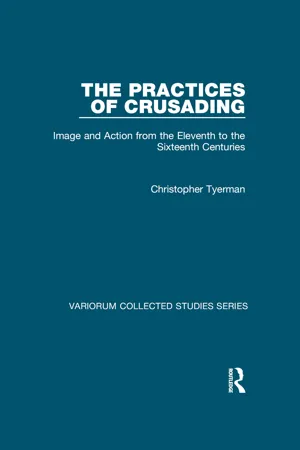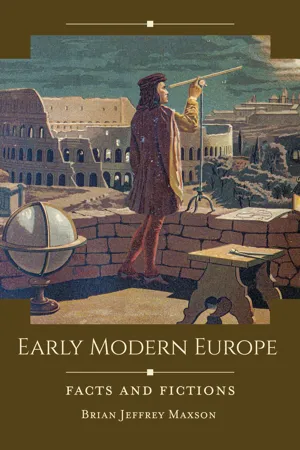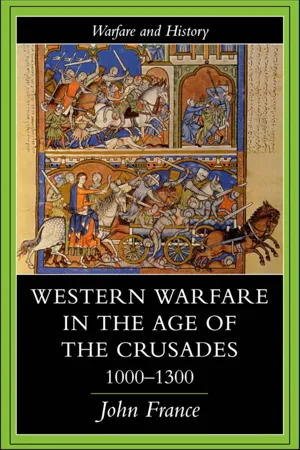History
The Crusades
The Crusades were a series of religious wars initiated by the Latin Church in the medieval period, primarily aimed at reclaiming the Holy Land from Muslim rule. Spanning from the 11th to the 13th century, the Crusades had significant political, economic, and social impacts, leading to the expansion of trade, cultural exchange, and the rise of powerful military orders.
Written by Perlego with AI-assistance
Related key terms
11 Key excerpts on "The Crusades"
- eBook - ePub
- Peter Lock(Author)
- 2013(Publication Date)
- Routledge(Publisher)
VI CRUSADES, CRUSADING AND THE CRUSADER STATES WHAT WAS A CRUSADE? The term ‘crusade’ is a modern not a medieval term. Its application as a title for the crusade movement seems to be no earlier than 1638 in Western Europe. Muslim sources did not distinguish between western pilgrims, crusaders, or settlers, labelling them all as Franks (al-Franj). It is only in the twentieth century that the literal term for crusade, al-salibiyyun, enters Arabic historical ‘riting. Interestingly, ‘rabic, Romance and Germanic words for ‘crusade’ derive etymologically from their word for ‘cross’, and thus emphasise the symbol of the cross in crusading activity 1 From the days of Gibbon there has been general agreement that The Crusades represented a turning point in European history, defining the nature of European identity and telling us as much about European medieval history as about the history of the Middle East. Until the present century this has led to a Eurocentric approach to crusading history. In the same vein Jewish historians thought that The Crusades exercised a profound influence on Jewish culture in Europe, and since the 1960s have traced the roots of the Holocaust back to the First ‘rusade. 2 Since the 1960s a debate regarding the unambiguous definition of the term ‘crusade’ has developed between the so-called traditionalists and the pluraliste The former hold that only those expeditions aimed at the recovery or defence of the Holy Land should be considered crusades, whilst the latter maintain that all expeditions authorised by the papacy with the concomitant crusade privileges, preaching and recruitment should be considered crusades. 3 The first approach privileges place — that is, the Holy Land — as the destination that made a true crusade. The second approach emphasises the procedural and organisational nature of crusading expeditions regardless of their destination - eBook - ePub
- Kathryn Hurlock(Author)
- 2012(Publication Date)
- Bloomsbury Academic(Publisher)
Chapter 4: Political CrusadesThe definition of what constitutes a crusade is open to debate. Different groups of historians, admittedly artificially defined for ease of comparison, take different views, believing that the location, target or motivations of a war determined its suitability for being defined as a crusade. Traditionalists see only campaigns launched to recover Jerusalem as true crusades; generalists argue that any Christian war fought for God was a crusade; popularists claim that crusading came out of popular, peasant movements; while pluralists argue that any war in which the participants took a vow and gained spiritual rewards could be seen a crusade.1 These definitions, put forward by Giles Constable in 2001, are not satisfactory and are sometimes controversial, but at present they are the clearest definitions in place, and they do help to distinguish between varying approaches to crusading amongst modern historians.2Pluralist interpretations of the crusade allow for a wider spread in crusading activity, which echoed the way in which the crusade was employed in medieval Europe. The success of the First Crusade, coupled with the papacy’s desire for reform, meant it was thus perhaps only a matter of time before the pope started to direct The Crusades against Christian enemies because of the opposition to papal policy, offering spiritual rewards for those who vowed to fight. The idea of ‘political’ crusades was (and still is) a contentious one: not all contemporaries viewed them as justifiable, and not all historians have seen them as ‘genuine’ crusades. To contemporaries, a crusade was a military venture - eBook - ePub
- Jonathan Riley-Smith(Author)
- 2008(Publication Date)
- Columbia University Press(Publisher)
CHAPTER ONE Crusades as Christian Holy WarsCrusades were penitential war pilgrimages, fought not only in the Levant and throughout the eastern Mediterranean region, but also along the Baltic shoreline, in North Africa, the Iberian Peninsula, Poland, Hungary and the Balkans, and even within Western Europe. They were proclaimed not only against Muslims, but also against pagan Wends, Balts and Lithuanians, shamanist Mongols, Orthodox Russians and Greeks, Cathar and Hussite heretics, and those Catholics whom the church deemed to be its enemies. The crusading movement generated holy leagues, which were alliances of front-line powers, bolstered by crusade privileges, and military orders, the members of which sometimes operated out of their own order-states.It is the length of time crusading lasted and its expression in many different theaters of war that make it so hard to define.1 It was adaptable and aspects of it changed in response to circumstances and even fashion, but certain elements were constant. To crusade meant to engage in a war that was both holy, because it was believed to be waged on God’s behalf, and penitential, because those taking part considered themselves to be performing an act of penance. The war was authorized by the pope as vicar of Christ. Most crusaders were lay men and women who made vows, committing themselves to join an expedition. When their vows were fulfilled, or when a campaign was considered to have ended, the individuals concerned resumed their normal lives. There were also crusaders of another type, the brothers (and in some cases sisters) of the military orders—such as the Knights Templar, Knights Hospitaller, and Teutonic Knights—who made vows of profession and were therefore permanently engaged in the defense of Christians and Christendom. The vows, whether specific and temporary, varying a little from place to place and over time, or permanent ones of profession into a military order, were symbolized by the wearing of crosses, either on everyday clothes or on religious habits. The lay men and women who made them were rewarded with indulgences, guarantees that the penitential act in which they were engaged would rank in God’s eyes as a fully satisfactory remission of the sins that they had committed up to that date.2 - eBook - ePub
Bullies and Saints
An Honest Look at the Good and Evil of Christian History
- John Dickson(Author)
- 2021(Publication Date)
- Zondervan(Publisher)
Holy Wars from the 1000s to the 1200s Lest we get on our high horse and think this is unique to some other place, remember that during The Crusades people committed terrible deeds in the name of Christ. —PRESIDENT BARACK OBAMA, 2015Ihave already talked about the First Crusade in some detail. Its themes and aims can, to some degree, stand as the model for later Crusades. It also represents a pivot point in the history of Christianity.First Crusade (1096–99)
Before Pope Urban II’s preaching campaign of 1095–96, warfare had an ambiguous status in Christian teaching. It was sometimes viewed as a necessary evil in a fallen world. And sometimes—especially in the early centuries—it waswholly rejected as a contradiction of the Gospel demand: “Love your enemies, do good to those who hate you” (Luke 6:27). I will discuss the backstory to Christian “sacred violence” later. For now, it is perhaps worth noting that historians typically speak about five different Crusades. This is, of course, a matter of convenience, an easy way to organise our thoughts on this subject. People in, say, the year 1203 did not talk about “Heading off to the Fourth Crusade”! Still, it is sometimes helpful to make our thoughts about history neater than the history itself.Several armies of European volunteers, amounting to something like one hundred thousand men, heeded the call of Pope Urban II to assist the Christian Byzantine emperor Alexius I against Muslim aggression. They hoped to protect Constantinople and win back Jerusalem for Christ. The campaign was a stunning success, from the Crusaders’ point of view. Even though only ten to fifteen thousand men reached Jerusalem in 1099, they were able to recapture the Holy City in a matter of weeks.Part of the First Crusade’s spiritual force, if I can call it that, came from a charismatic monk known as Peter the Hermit. His dishevelled appearance obscured a keen talent for recruitment and the management of soldiers, as well as a fiery preaching style. It is unclear whether he was the pope’s appointee or just a successful independent zealot who supported the cause. He rallied up to thirty thousand men from France and Germany, both peasants and some elites. He personally led them toward the Holy Land, across the Rhineland in central Germany, down the Danube River to the Balkans, across to Constantinople, and then on toward Jerusalem via Syria. “His message was revivalist,” explains Oxford’s Christopher Tyerman, “peppered with visions and atrocity stories.”1 Peter himself was the source of several atrocities. As he marched through the Rhineland, he and his men slaughtered Jewish communities, partly for their supposed responsibility for the death of Christ centuries earlier and partly for their alleged complicity in recent Muslim attacks on Christian sites in Jerusalem (more perversely, it may also have just been fighting practice).2 Anti-Semitism had a long history in Christianity, going back at least as far as the fourth century, but it rarely took the form of Peter’s full-scale pogroms in 1096. There were massacres and/or forced conversions in Mainz, Cologne, Regensburg, and Prague. The majority of armies organised by Pope Urban apparently did not participate in such violent persecutions of Jews. And, curiously, various otherChristian armies attacked and defeated some of Peter’s men for their indiscriminate violence.3 But Peter remained a major figure in the First Crusade, even preaching a sermon—a pregame pep talk—on the Mount of Olives overlooking Jerusalem on the eve of the sacking of the city.4 - eBook - ePub
The History of Christianity
Facts and Fictions
- Dyron B. Daughrity(Author)
- 2019(Publication Date)
- ABC-CLIO(Publisher)
The Crusades are misunderstood for a variety of reasons: they occurred a thousand years ago, few professors today are specialists in medieval Christianity, and they represent a time when Christianity was understood so differently than it is today. Nevertheless, the misunderstanding of this particular era in the Christian faith is conspicuous and pronounced, largely because it is built on assumptions that have been shaped in a context that abhors the idea of Christians voluntarily killing others in the context of holy war. People in the Western world today, in a postcolonial context, have little appetite for a kind of Christianity that was inextricably tied to the state. In the medieval era, there was hardly a war that was not a holy war on some level, due to the ubiquity of religion throughout the society and, therefore, its political institutions. That kind of Christianity is repulsive to many.Thus, today, The Crusades are associated with overzealousness, with a worldview in which there was no separation between church and state, and with violence. And while all three of these charges are true in some respects, they fail to include the broader context.How the Story Became PopularThe historiography of The Crusades is actually quite well-researched among those few scholars who specialize in this area, and what emerges is a fascinating story of how civilization can dramatically change its perspective on a person or event in history. During the era of The Crusades, Western Europeans tended to write about them in a “triumphalistic” way. However, by the end of the eighteenth century, that interpretation had completely changed to one of “skepticism and sharp criticism” (Peters 2004, 6).Muslim historians did not pay much attention to The Crusades while they were happening. They occurred in “a politically and economically marginal area” that attracted little attention. At the time, Muslims regarded the crusaders as “primitive, unlearned, impoverished, and non-Muslim people.” Muslim scholars “knew and cared little” for these Western warriors. Their view of the crusaders could be summarized with one word: indifference. Indeed, Arab chroniclers had no word for “crusades” until the mid-nineteenth century, when they began using the expression “wars of the cross” (al-hurub al-salibiyya) (Peters 2004, 6–7).The Ottoman Turks did write some on The Crusades, but by far the dominant concern of their historians during the thirteenth century was the Mongol conquests. Interest in The Crusades did not resurface in any significant way in the Muslim world until the mid-nineteenth century, when French histories of The Crusades began to be translated into Arabic and Turkish by Europeans. This period “marks the beginning of European revisionist historiography on The Crusades.” In the eighteenth and nineteenth centuries, some of Europe’s most prolific historians turned their attention to The Crusades. In the eighteenth century, Voltaire, Hume, Diderot, and Gibbon dominated European historiography and tended to characterize The Crusades as a papist concern to invigorate the finances of the Roman Catholic Church (Peters 2004, 7). Safe to say, their understanding of The Crusades was openly critical and terribly biased—against the church. - eBook - ePub
Towards the Prophetic Church
A Study of Christian Mission
- Hull(Author)
- 2014(Publication Date)
- SCM Press(Publisher)
It has now become clearer that very few Crusaders gained material benefit from their activities (Tyerman 1988, p. 18). Indeed, on the contrary, many individuals and families made considerable sacrifices to fulfil what they came to see as their religious duty to go on armed pilgrimage. Many people still think of The Crusades as expeditions aimed at the recovery or defence of Palestine, but it has become clearer that crusading was a far more general phenomenon. ‘It is now clear that the fourteenth century, like the thirteenth, was one in which there was hardly a year in which a crusade was not being waged somewhere’ (Riley-Smith 2009, p. x).The recovery of the Iberian Peninsula from the Moors, which began in a significant way with the Battle of Tours won by the Franks in 732, and was not complete until the fall of Granada in 1492, occupying nearly 800 years, was again and again blessed by the popes and given the status of a Crusade (Riley-Smith 1981, pp. 15–16). The Northern Crusades fought against the Baltic and eastern European countries between the twelfth and fourteenth centuries in which the military orders played a prominent part, were given the status of Crusades from the time of Pope Celestine III in 1193 (Christiansen 1997). There were Crusades against secular authorities and against fellow Christians in southern Germany and in south-western France.In understanding this we must consider the prevailing political philosophy in which Christendom was ‘seen not merely as a society of Christians but as a universal state, the Christian Republic, transcendental in that it existed at the same time in heaven and on earth’ (Riley-Smith 2009, p. 24). This universal state had been established by Christ for the benefit of all humanity. It was not only a Christian republic; it was a monarchy of which Christ was the King (p. 25). - eBook - ePub
The Practices of Crusading
Image and Action from the Eleventh to the Sixteenth Centuries
- Christopher Tyerman(Author)
- 2023(Publication Date)
- Routledge(Publisher)
routiers of Languedoc in 1139, or recalcitrant peasants in the Netherlands and north-west Germany in the 1220s. Crusades against Christian enemies of the Papacy became the most characteristic – and most controversial – form of crusading in the thirteenth and fourteenth centuries.The other main targets of crusades in Europe were heretics, notably the Cathars (or Albigensians) between 1208 and 1229, although charges of heresy could be employed by unscrupulous rulers, such as the kings of Hungary against the Bosnians in the 1230s, driven by zeal to acquire more land and power, a motive not far from the thoughts of King Louis VIII of France when campaigning against the Cathars in 1226. As the anti-Hussite crusades in Bohemia in the fifteenth century show, the combination of religious outrage and political ambition retained its potency. In the thirteenth century, the need to defend the Latin Empire of Constantinople and the western conquests in Greece and the Aegean established after the Fourth Crusade in 1204 led, especially after the 1230s, to regular appeals for crusades against the Byzantines.The flexible nature of the crusade as a political device is further revealed in its use from the fourteenth century in the conquest and conversion of pagan lands in Africa, the Atlantic and the Americas where the underlying justification of defence and reconquest was expanded to include the extension of Christendom.Static neither in application nor in administration, the range of the wars of the Cross, from Russia to Spain, from England to Egypt, the involvement of so many diverse communities and the longevity of at least some associated ideals, reflected crusading’s part in three powerful social and cultural forces: the expansion of western Christendom beyond its early medieval frontiers; the development of internal structures of authority and order in Church and State; and the religious reformation of the laity, spearheaded by the crusader pope Innocent III and the Fourth Lateran Council of 1215.Nevertheless, while it may have been a characteristic feature of western European politics and Church, crusading was not a monolithic movement. Many modern historians have regarded The Crusades as an autonomous force, exerting profound influence on medieval culture of which crusading was a ‘defining characteristic’ (Lloyd 1995 : 36). When likened to a ‘cancer inside the body of medieval Christendom … carried to every part of the organism’, crusading’s discrete existence is still acknowledged (Morris 1998 - eBook - ePub
Early Modern Europe
Facts and Fictions
- Brian Jeffrey Maxson(Author)
- 2023(Publication Date)
- Bloomsbury Academic(Publisher)
The myth goes that The Crusades consisted of nine distinct events spread out over a bit more than 200 years of history. Over time, it became clear that the land route from Europe to the Holy Land was not working. Thus, Crusaders began sailing to Egypt and then trying the shorter land passage to Jerusalem. These different Crusades often sought both to retake lands from Islam and to provide aid to the Crusader Kingdoms established after the First Crusade. Those Crusader Kingdoms were Christian bulwarks in Islamic lands. Each heavily fortified kingdom fought never-ending wars against bellicose people who simply viewed the world differently than they did. The fall of the last Christian outposts at Acre in 1291 ended The Crusades. From that point onward, Europeans lacked a foothold in the east. Additionally, their conflicts became simply different than The Crusades had been. During The Crusades, according to the myth, big armies had fought huge campaigns aimed at conquering the Holy Land. They had adopted the Cross as their symbol. They had fought for religious purposes. The myth goes that all of that ended in 1291. Armies stopped seeking the Holy Land or wearing the cross. A stalemate began between the Islamic East and the Christian West.Scenes from the Eighth Crusade of King Louis IX of France and his troops arriving in Tunis, and then being attacked by Muslims, from Chroniques de France ou de St Denis, mid-13th century. Popular myth holds that The Crusades were a series of distinct, numbered events, fought between the West and the East, with a clear beginning and clear ending during the medieval period. However, historians debate what made The Crusades different from other kinds of warfare and pilgrimage. The same kinds of wars and calls to crusade continued throughout the early modern period. Clear lines between religions could define conflicts and daily life, but wars and daily life also could defy such clear boundaries. (The British Library)How the Story Became PopularThe idea that The Crusades began in 1095 at the Council of Clermont and ended in 1291 at Acre had already been established by the 1700s. In that century, authors like Voltaire and David Hume presented The Crusades as something focused exclusively on the Holy Land. Moreover, The Crusades were part of a distant, superstitious past. Enlightenment writers sought to show that The Crusades had ended and were yet another example of medieval darkness dispelled by recent rationalism. During the 1800s, these Enlightenment ideas combined with European imperialism: The Crusades were an example of a past when Europeans had fought for and conquered faraway lands. One of the most influential writers of this period was the novelist Walter Scott. For example, Scott popularized the still common idea of the enlightened Sultan Saladin. By the time World War I started in the early twentieth century, The Crusades had offered national heroes like Richard the Lionhearted. - eBook - ePub
Franks and Saracens
Reality and Fantasy in the Crusades
- Avner Falk(Author)
- 2018(Publication Date)
- Routledge(Publisher)
In his studies of the ideas, language, practice, and reception of crusading, and its historiography, he suggested that The Crusades reflected the religious and political habits and ambitions of their time, rather than moulding them. Crusading was a malleable phenomenon within Mediœval western society even since 1095, provoking widely divergent views among its participants, witnesses, and commentators. Tyerman believed that crusade literature and historiography often say more about the authors themselves than about what they claim to have seen. The British historian Elizabeth Siberry examined the British historiography of The Crusades in the nineteenth and twentieth centuries and reached similar conclusions (Siberry, 2000). In an online interview with the US National Public Radio in 2005, Tyerman stated his views: There was no strategic reason for Western knights and soldiers to be laboring about in the Judean hills in the 11th, 12th and 13th centuries. They were there for essentially ideological religious reasons. The Holy Land and Jerusalem were regarded as part of Christendom, as a relic, and the Crusaders went there, in a sense, to establish a protective garrison to restore, as they saw it, their holy city to Christian control. But the prime motive of crusading in the Holy Land, unlike crusading in Spain or in [the] Baltic, was not initially that of settlement. If you wanted to make a profit, you did not go on Crusade. Crusaders habitually made thumping losses. [Tyerman, 2005b] Tyerman believed that the chief motive for The Crusades was religious: the idea of “holy war”. In a similar vein, conventional historical wisdom about The Crusades was challenged by the Israeli geographer Ronnie Ellenblum in his books on The Crusades (Ellenblum, 1998, 2007) - John France(Author)
- 2020(Publication Date)
- Routledge(Publisher)
Chapter Fifteen Crusading and warfare in the Middle East Conquest in the Middle Ages was always difficult. Even the greatest kings found collecting resources complicated and persuading followers problematic, which is why it was usual to try to come to terms with the existing population. Distance, geography and weather made the process complex and liable to miscarry. Yet in 1095 a pope, Urban II (1088–99), proposed a military expedition to seize the city of Jerusalem, some 4,000km distant from Clermont where he was preaching, in a land strange to most of his listeners, with a climate they would find harsh, occupied by people of an alien religion who would brook no compromise. There was no great leader with a retinue of predatory followers to take command, and he offered no pay to those who went. What was proposed appears as ideological warfare in the purest sense: that men should leave their riches, their wives and their lands to free Jerusalem from the infidel, thus gaining an indulgence – release from the burden of sin – and, if death should overcome them, immediate entry into the kingdom of heaven. It is strange is that such an idealistic appeal should be directed to a class whose primary preoccupation was landholding by one who was, after all, drawn from their ranks. What is even stranger is that it succeeded, for the First Crusade brought together an army of over 60,000, including in its ranks 6,000–7,000 cavalry drawn from the ranks of the leaders of society. 1 But this is not such a great paradox. Men and women did not make their decisions, even about peace and war, solely on the basis of proprietorial considerations – it was simply that in any serious matter these played a major, and often the major, role. It would be an impossibly narrow view of human motivation to believe that it was always entirely material- John France(Author)
- 2002(Publication Date)
- Routledge(Publisher)
Chapter Fifteen Crusading and warfare in the Middle East Conquest in the Middle Ages was always difficult. Even the greatest kings found collecting resources complicated and persuading followers problematic, which is why it was usual to try to come to terms with the existing population. Distance, geography and weather made the process complex and liable to miscarry. Yet in 1095 a pope, Urban II (1088-99), proposed a military expedition to seize the city of Jerusalem, some 4,000km distant from Clermont where he was preaching, in a land strange to most of his listeners, with a climate they would find harsh, occupied by people of an alien religion who would brook no compromise. There was no great leader with a retinue of predatory followers to take command, and he offered no pay to those who went. What was proposed appears as ideological warfare in the purest sense: that men should leave their riches, their wives and their lands to free Jerusalem from the infidel, thus gaining an indulgence - release from the burden of sin - and, if death should overcome them, immediate entry into the kingdom of heaven. It is strange is that such an idealistic appeal should be directed to a class whose primary preoccupation was landholding by one who was, after all, drawn from their ranks. What is even stranger is that it succeeded, for the First Crusade brought together an army of over 60,000, including in its ranks 6,000-7,000 cavalry drawn from the ranks of the leaders of society. 1 But this is not such a great paradox. Men and women did not make their decisions, even about peace and war, solely on the basis of proprietorial considerations - it was simply that in any serious matter these played a major, and often the major, role. It would be an impossibly narrow view of human motivation to believe that it was always entirely material
Index pages curate the most relevant extracts from our library of academic textbooks. They’ve been created using an in-house natural language model (NLM), each adding context and meaning to key research topics.
